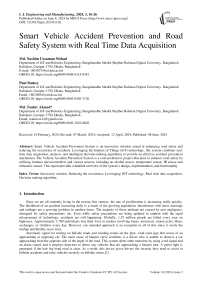Smart Vehicle Accident Prevention and Road Safety System with Real Time Data Acquisition
Автор: Md. Nashim Uzzaman Nishad, Paul Baskey, Md. Toukir Ahmed
Журнал: International Journal of Engineering and Manufacturing @ijem
Статья в выпуске: 3 vol.14, 2024 года.
Бесплатный доступ
Smart Vehicle Accident Prevention System is an innovative solution aimed at enhancing road safety and reducing the occurrence of accidents. Leveraging the Internet of Things (IoT) technology, this system combines real-time data acquisition, analysis, and intelligent decision-making algorithms to provide an effective accident prevention mechanism. The Vehicle Accident Prevention System is a com-prehensive project that aims to enhance road safety by utilizing Arduino microcontrollers and various sensors, including an alcohol sensor, temperature sensor, IR sensor and ultrasonic sensor. This report provides a detailed overview of the system’s design, implementation, and functionality.
Innovative solution, Reducing the occurrence, Leveraging IOT technology, Real time data acquisition, Decision making algorithm
Короткий адрес: https://sciup.org/15019332
IDR: 15019332 | DOI: 10.5815/ijem.2024.03.02
Текст научной статьи Smart Vehicle Accident Prevention and Road Safety System with Real Time Data Acquisition
Since we are all currently living in the twenty-first century, the rate of proliferation is increasing really quickly. The likelihood of an accident increasing daily is a result of the growing population. Interference with these meetings and mishaps are a growing problem in modern times. The majority of these mishaps are caused by unit negligence, disregard for safety precautions, etc. Even while safety precautions are being updated in tandem with the rapid advancement of technology, accidents are still happening. Globally, 1.35 million people are killed every year on highways. Approximately 3,700 individuals lose their lives in crashes involving buses, motorcars, motorcycles, bikes, exchanges, or climbers every day. However, our intended approach is an exception to all of this since it averts the mishap and thereby saves lives.
Automatic signal for turning on hillside roads and winding routes on the ghat. wind road sign that warns of an approaching or opposing car. The main cause of hairpin curve accidents is a driver who is unable to observe a car approaching from the opposite side of the angle of the road. This system alerts other motorists by using a red signal and an alarm sound, and it employs detectors to detect any vehicles that are approaching a hairpin turn. A green light is generated if the hair leg bend road is clear. As a result, this device gives drivers the security they need to assist in hillside accidents and raise vehicles securely on hillside routes.[1]
-
A. Objectives
i) Effectively anticipates, detects, and mitigates potential road hazards in real time.
ii) Aiming to drastically reduce vehicular accidents.
iii) Enhance overall road safety.
iv) And save lives through proactive safety measures and timely interventions.
2. Literature Review
3. Methodology
Table 1. Paper Review
|
No. |
Paper Title |
Objective |
Achievement |
Limitation |
|
1. |
Determining the Effect Rate of Speed, Volume of Passenger Cars, Heavy Vehicles and Light Non-Passenger Car Vehicles on Likelihood of Accidents on Urban Highways [1] |
environments.
contribute knowledge that can be utilized to reduce accident rates, enhance road safety, and potentially save lives on urban highways by addressing speed and vehicle volume-related factors. |
|
|
|
2. |
Vehicle Accident Prevention System [2] |
|
1.In-depth Analysis of Vehicular Accident Causes: The paper provides a comprehensive examination of the causes of vehicular accidents, particularly emphasizing the role of drowsiness among drivers, and its significant contribution to road accidents. 2. Innovative Technology Integration: Presenting an innovative approach to combat driver tiredness by integrating wireless technologies, an eye blink sensor, and an automated braking system and its potential to prevent accidents. This innovative system attempts to mitigate accidents by slowing down or halting the vehicle when drowsiness is detected. |
|
|
3. |
Sensor Based Accident Prevention System in Curving [3] |
|
|
|
|
4 |
Smart Road Safety and Automatic Vehicle Accident Prevention System for Mountain Roads [4] |
|
|
|
|
5. |
Design of Vehicle Accident Prevention System Using Wireless Technology [5] |
|
|
|
This work focuses on providing a clear explanation of the styles used to accomplish the specified goals and outlines the process of creating the system model. The model was broken down using programming and simulation to see how effective the design under consideration was. Proteus, a computer program, was utilized to simulate and build the circuit for the automobile accident containment system employing an Arduino, an automatic retardation system, and temperature, alcohol, and ultrasonic detectors.
Here we used ultrasonic sensor, alcohol sensor, and temperature sensor. The ultrasonic sensor will work as an automatic brake when it sees an object or person coming in front of our car. That is, the motor of the car will be off. Again in the case of alcohol sensor it is often seen that the driver is driving under the influence of alcohol. In that case there is a possibility of an accident. Here we have used alcohol sensor to detect when the driver is intoxicated and if the driver is intoxicated then the motor of the car will be turned off. Again, many times it is seen that due to excess temperature, the car catches fire. In this case we used temperature sensor. So that the car's engine heats up and gives us a signal before the fire starts and the car's engine turns off.

-
Fig. 1. Circuit Diagram for vehicles
Step 1: This System we used Arduino UNO board.
Step 2: Then we connected Alcohol sensor, Ultrasonic sensor and Temperature sensor.
Step 3: We also included buzzer, LED and 5v motor.
Step 4: Use batteries for provide power of the systems.

-
Fig. 2. Flowchart for Vehicles
Step 1: We turn on our system
Step 2: First of all, we check alcohol by alcohol sensor if detect alcohol then vehicles motor off and turn off the system, buzzer on. Otherwise motor active and our system go to next step.
Step 3: Similarly our system check all function. If yes motor off otherwise motor active.
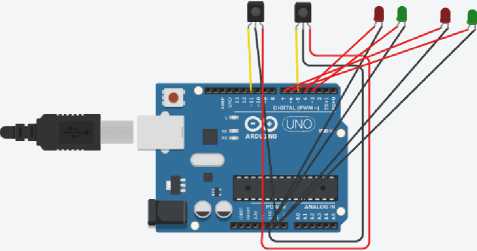
-
Fig. 3. Circuit Diagram for smart road
Connect the IR sensors to the Arduino Uno board. Ensure proper wiring and connections for both IR sensors.
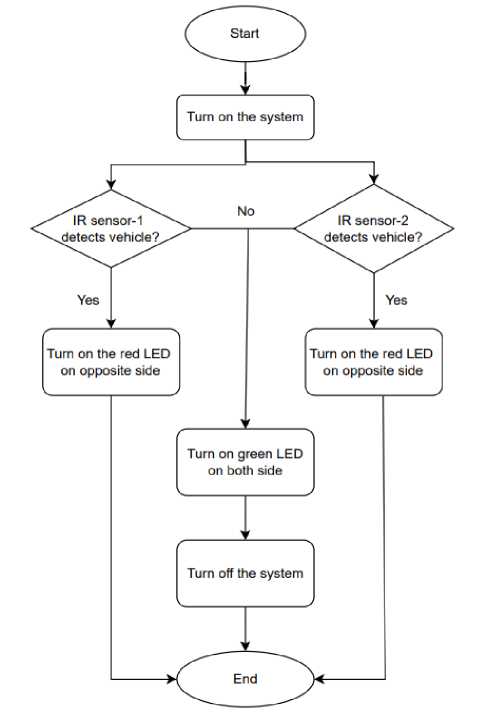
Fig. 4. Flowchart for Smart road
4. Hardware Component
4.1. Arduino UNO
Step 1: We turn on our system
Step 2: If detect vehicles in opposite side, then turn on red Led.
Step 3: If no detect any vehicles in opposite road then, then turn on green Led.
The Arduino Uno—a little powerhouse in the world of microcontrollers! Picture it as the beating heart of countless electronic projects. The Arduino Uno is like the superhero of the DIY electronics realm, swooping in to make your wildest gadget dreams a reality. At its core, it's armed with an ATmega328P microcontroller, a pint-sized genius that follows your programming orders. What makes it such a darling is its simplicity. It's like the gateway drug to the world of microcontrollers—a perfect starting point for beginners and a trusty sidekick for seasoned tinkerers.
Table 2. Total required components
|
Components Name |
Required Amount |
|
Arduino UNO |
2 |
|
Alcohol Sensor |
1 |
|
Ultrasonic Sensor |
1 |
|
Temperature Sensor |
1 |
|
IR Sensor |
2 |
|
Relay Module |
1 |
|
5v Motor |
1 |
|
Breadboard |
2 |
|
Buzzer |
1 |
|
LED |
6 |
|
Jumper wire |
30 |
Physically, it's a small board with a bunch of digital and analog pins. These are like the connective tissue, allowing you to hook up sensors, displays, and other electronic doodads. There's a USB port for easy programming, a power jack to keep it juiced up, and a reset button for those "just in case" moments.Coding for the Arduino Uno is like crafting spells in a digital wizard's workshop. The Arduino IDE is your spell book, where you concoct the magical words (code) that bring your creation to life. The programming language is a bit like C++, but fear not—it's designed to be newbiefriendly [8]
-
4.2. Alcohol Sensor
-
4.3. Ultrasonic Sensor
-
4.4. Temperature Sensor
An alcohol sensor, sometimes known as a breathalyzer, is a tool used to gauge how much alcohol is in a person's breath. Law enforcement organizations frequently utilize it to determine whether a driver is under the influence of alcohol. The idea behind how it works is quite clever. Alcohol is taken into your bloodstream upon consumption. As your blood circulates through your lungs, some of the alcohol molecules move from the blood to the air sacs in your lungs. When you exhale, these alcohol molecules are expelled in your breath. The alcohol sensor detects and analyzes these molecules. One popular method is using a semiconductor-based sensor that reacts with alcohol, causing changes in electrical conductivity. The level of conductivity change is then correlated with the alcohol concentration in the breath, providing a fairly accurate estimate of blood alcohol content [9]
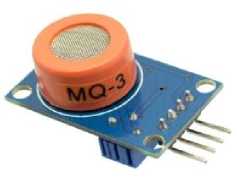
Fig. 5. Alcohol sensor
The ultrasonic sensor—a silent hero in the world of distance measurement! Picture it as a bat using echolocation, but for your electronic projects. These little wonders send out ultrasonic pulses and listen for their echo to determine how far away objects are. Here’s the science behind it: an ultrasonic sensor typically has a transmitter and a receiver. The transmitter sends out ultrasonic waves, which are inaudible to our human ears but bounce off objects. After the echoes are picked up by the receiver, the sensor measures the distance by figuring out how long it takes for the waves to return. Imagine using this in a robot to help it avoid obstacles. As it moves, the ultrasonic sensor acts like its eyes, constantly measuring the distance to nearby objects. If something gets too close, the robot can adjust its path, avoiding collisions like a seasoned dancer on a crowded dance floor.
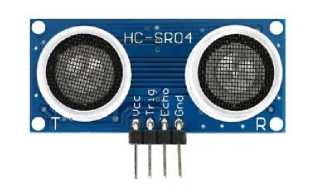
Fig. 6. Ultrasonic Sensor
Temperature sensors play a critical role in industrial settings, where precise temperature control and monitoring are essential for ensuring product quality, process efficiency, and operational safety In industrial applications, various types of temperature sensors are employed based on the specific requirements of the processes involved. Such as
Thermocouples used due to their durability and ability to measure a wide range of temperatures. They are suitable for harsh industrial environments where high temperatures and rugged conditions are common.[11]
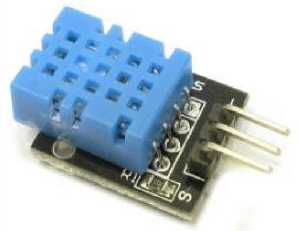
Fig. 7. Temperature Sensor
-
4.5. IR Sensor
-
4.6. Relay Module
Sensors that monitor and identify infrared radiation in the surrounding environment are known as infrared (IR) sensors. They are widely used for a variety of purposes and are made to detect infrared light, which is invisible to the human eye.
Types of IR Sensor:
Passive Infrared (PIR) Sensors: These sensors detect the movement of infrared radiation emitted by objects, allowing them to sense motion. PIR sensors are commonly used in security systems, automatic lighting, and occupancy detection in buildings.
Thermal Infrared Sensors: These sensors detect the temperature of objects by measuring their emitted infrared radiation. They are used in non-contact temperature measurement in industrial processes, medical devices (like thermometers), and even in environmental monitoring.15]

Fig. 8. IR Sensor
A relay module is an electromechanical device that consists of one or more relays. These modules serve as an interface between a microcontroller, such as an Arduino or Raspberry Pi, and higher-power devices that require switching or control. Relays are commonly used for their ability to control high-voltage, high-current loads using low-voltage digital signals. [16]
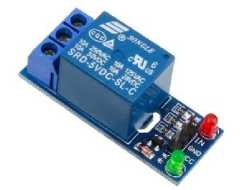
Fig. 9. Relay Module
-
4.7 DC Motor
-
4.8 Breadboard
-
4.9 Buzzer
An electric motor that uses the interplay of magnetic fields to transform electrical energy into mechanical energy is called a DC (direct current) motor. The most popular varieties base their calculations on the glamorous forces generated by the coil currents. Almost every kind of DC motor has an internal medium—electromechanical or electronic—that allows the motor's partial current to be periodically reversed. Since direct-current lighting power distribution systems could power DC motors, they were the first type of motors to be widely employed. A DC motor's speed can be adjusted across a broad range by adjusting the field windings' current strength or applying a variable force voltage. The feathery brushed universal motor can run on both direct current and intermittent current, making it suitable for use with portable power tools and appliances. Nowadays, larger DC motors are utilized in the drives of brand-name rolling factories, elevators, and hoists. The development of power electronics has allowed for the replacement of DC motors in numerous processes with AC motors. [17]
A breadboard is a fundamental tool used in electronics prototyping and experimentation. It provides a platform for building and testing electronic circuits without the need for soldering. Its design allows components to be easily inserted and interconnected, enabling rapid construction and modification of circuits.
The name "breadboard" originated from its early use in prototyping circuits for electronic equipment, where builders would use wooden breadboards to arrange and connect components.
The basic structure of a breadboard consists of a plastic housing with multiple interconnected sockets and holes that are organized into grids. These grids or matrices typically have rows and columns of interconnected metal clips or tie points underneath the board's surface.[11]
A buzzer is an electro-acoustic device that produces sound, typically a buzzing or beeping noise. It's a simple and commonly used signaling device in various electronic systems and everyday applications, designed to generate audible alerts or notifications.
Buzzer Types:
1. Electromagnetic Buzzers: These buzzers consist of an electromagnet and a diaphragm. When an electrical current is applied to the electromagnet, it creates a magnetic field that causes the diaphragm to vibrate, producing sound.
2. Piezoelectric Buzzers: These buzzers use the piezoelectric effect to produce sound. When voltage is applied to a piezoelectric material (like a ceramic disc), it vibrates, creating sound waves.
5. Software Components
5.1 Arduino IDE
6. Result and Discussion
Code can be written and uploaded to Arduino-based microcontroller boards using the open-source Arduino Integrated Development Environment (IDE). For a variety of projects and applications, it offers an intuitive interface for creating, assembling, and uploading code to the Arduino board.
Vehicle accident prevention systems that incorporate ultrasonic, alcohol, temperature, and infrared (IR) sensors offer a comprehensive approach to enhancing safety on the roads. These sensors provide valuable data about the vehicle’s surroundings, driver condition, and potential hazards, allowing the system to take appropriate preventive measures. Let’s discuss the results and key findings related to this combination of sensors in accident prevention systems.
Ultrasonic sensors are frequently employed in car accident prevention systems to identify obstructions nearby for the purposes of obstacle detection and collision avoidance. These sensors produce sound waves and time how long it takes for them to return after colliding with an item. Through the analysis of this data, the system is able to calculate the distance to objects in the vicinity and provide alerts or initiate independent actions to prevent collisions. According to studies, ultrasonic sensors are a useful tool for detecting both moving and stationary objects, which lowers the possibility of accidents brought on by unexpected obstructions or blind areas.
Impaired Driver Detection: Alcohol sensors are designed to detect the presence of alcohol in a driver’s breath or within the vehicle cabin. These sensors help identify drivers who are under the influence of alcohol, a significant risk factor for accidents. When an alcohol sensor detects alcohol beyond a certain threshold, the accident prevention system can issue alerts to the driver, limit the vehicle’s speed, or even prevent the vehicle from starting. Results have indicated that alcohol sensors contribute to reducing accidents caused by impaired driving.
Engine Monitoring: Temperature sensors can be used to monitor the engine’s condition and alert the system if signs of drowsiness or fatigue are detected. By measuring changes in temperature, the system can estimate the engine’s level of alertness. If signs of fatigue are detected, the system can provide warnings to the engine or recommend taking a break. Engine monitoring using temperature sensors can help prevent accidents.
Opposite side vehicle detection: When another vehicle comes from the opposite side, the red light will be detected by the IR sensor, and the car driver can be alert in advance. Otherwise the green light will always be on.

Fig. 10. Smart Road Safety and Vehicle accident prevention system
There have been several projects related to IOT based vehicle accident prevention system. Here are some examples:
Assessing the Impact of Speed, Passenger Car Volume, Heavy Vehicle Volume, and Light Non-Passenger Car Volume on the Probability of Accidents on Urban Highways [1].
Difference in used equipment-
Table 3. Used equipment in this paper
|
Alcohol sensor |
Ultrasonic sensor |
IR sensor |
|
No |
No |
Yes |
Table 4. Used equipment in our paper
|
Alcohol sensor |
Ultrasonic sensor |
IR sensor |
|
Yes |
Yes |
Yes |
Sensor Based Accident Prevention System in Curving [3]. Difference in used equipment-
Table 5. Used equipment in this paper
|
Alcohol sensor |
IR sensor |
Temperature sensor |
|
No |
Yes |
Yes |
Table 6. Used equipment in our paper
|
Alcohol sensor |
IR sensor |
Temperature sensor |
|
Yes |
Yes |
Yes |
These projects demonstrate the versatility and adaptability of IOT based vehicle accident prevention system. They also provide valuable insights into the design, construction, and programming of such devices.
7. Conclusion
In conclusion, vehicle accident prevention systems have made significant advancements in recent years, incorporating technologies that enhance driver awareness, automate critical safety functions, and enable vehicles to communicate with each other. These systems have proven to be effective in reducing accidents and saving lives by providing timely warnings, assisting drivers in making safer decisions, and even intervening autonomously to prevent collisions. How- ever, it’s important to note that driver education, responsible driving behavior, and proper maintenance of vehicles are also essential components of a comprehensive approach to road safety. The development and implementation of the vehicle accident prevention system represent a significant stride toward enhancing road safety, particularly in challenging terrains like mountainous or treacherous roads. By integrating innovative technology, such as ultrasonic sensors, Arduino UNO the system has shown promising capabilities in detecting and alerting drivers about potential hazards, ultimately aiming to reduce the occurrence of accidents. Throughout the project, it became evident that the hazards on certain roads, such as steep climbs, narrow curves, and limited visibility, significantly contribute to accidents. This system addresses these challenges by providing real-time alerts to drivers through LED indicators upon detecting obstacles, aiming to mitigate accidents caused by reduced visibility and unexpected obstacles. The successful testing and validation of the system underline its potential effectiveness, yet several aspects, including environmental factors and driver responsiveness, should be further addressed for improved reliability and functionality. Moreover, the scalability and economic feasibility of widespread implementation require careful consideration.
In conclusion, while this project marks a significant step in the direction of road safety, further research, development, and potential policy advocacy are vital to refine and expand such accident prevention systems. Continued collaboration and innovation in this field hold the promise of reducing the toll of accidents on perilous roads, ensuring safer journeys for all drivers and commuters.
8. Future Work
Here are some potential areas for future work:
-
1. Advanced Sensor Technologies: Continuously explore and integrate more advanced sensors, such as lidar, eye blink sensors, and thermal cameras, to enhance data collection and improve the system's ability to detect potential risks.
-
2. Machine Learning and AI: Develop machine learning and artificial intelligence models for more accurate and context-aware risk assessment. These models can learn from historical data and adapt to changing road conditions and driver behaviors
Acknowledgment
It is our great fortune that we have had the opportunity to carry out this project's work under the supervision of our honorable teacher, Md. Toukir Ahmed, Lecturer, Department of IRE, BDU. We express our sincere thanks and deepest sense of gratitude to my guides for their constant support, unparalleled guidance, and limitless encouragement. We wish to convey our gratitude to the authority of BDU for providing all kinds of infrastructural facilities for the project.
Список литературы Smart Vehicle Accident Prevention and Road Safety System with Real Time Data Acquisition
- S. Kaplan and C. G. Prato, “Risk factors associated with bus accident severity in the United States: a generalized ordered logit model,” Journal of Safety Research, vol. 43, no. 3, pp. 171–180, 2012.
- Mrs Y. Lavanya, M. Monika Rani, M. Sai Swaroop, P. Raja, Y. Rajesh, Dr. L.Bharathi “Smart Road Safety and Vehicle Accident Prevention System for Mountain Raods” JAC: A Journal of Composition Theory published in August 2021 volume XIV, Issue VIII ISSN:0731-6755.
- Aravinda Chaithralakshmi, Deeksha, Ashuthos “Sensor Based Accident Prevention System” International journal of innovative research in electrical, electronic and instrumentation and control engineering Vol 4, Issue 6, June 2016.
- Ki-Hyeon Kim., Dong-Hoon Yum., et.al. : Improving drivers visual field using estimation of curvature, IEEE Int. Conf. On Control Automation, Control, and Intelligent Systems (CYBER).pp. 115-120(2015).
- Mohn. T. (2016). Drowsy related accident: Forbes.com. Governors Highway Safety Association (GHSA), 08/08/16.
- Adu.A. (2017, April,03) Road Accident in Ghana: Pulse.com.Gh Dankyi, D. A. (2010) Tema records 75 deaths in 732 Accidents betweenJanuary-September.
- World Health Organization. (2009). Global status report on road safety. Retrieved from the World Wide Web .
- Aravinda B, Chaithralakshmi C, Deeksha, Ashutha K “Sensor Based Accident Prevention System” InternationalJournal of Innovative Research in Electrical, Electronics, Instrumentation And Control Engineering Vol. 4, Issue 6, June 2016.
- Kartik Venkata Mutya, Sandeep Rudra “Road Safety Mechanism to Prevent Overtaking Accidents” International Journal of Engineering Trends and Technology (IJETT) – Volume 28 Number 5 - October 2015.
- Ranga Sreedhar Galla “Diminishing Road Accidents on Sharp Curves Using Arduino” ISSN: 2456-9992.
- R. Meena, R.Lavanya and K.Suresh Kumar “Pre-Crash Sensing and Warning System in Hilly Region” Asian Journal of Applied Science and Technology (AJAST) Volume 1, Issue 3, Pages 08-10, April 2017.
- Stephen Eduku, Mohammed Okoe Alhassan, Joseph Sekyi “Design of Vehicle Accident Prevention System Using Wireless Technology” International Journal of Scientific and Research Publications, Volume 7, Issue 10, October 2017 ISSN 2250-3153
- A.Deepa Lakshmi, B.Nivetha, A.Jaya Kumar, R.Malar “The Literature Survey Based On Car Safety System That Spots Driver Errors” International Journal of Engineering Research and Development e-ISSN: 2278-067X.
- D. Haripriya, Puthanial. M, Dr. P. C. Kishore Raja “Accident Prevention System and Security for Vehicles” International Journal of Computer Trends and Technology (IJCTT) – volume 12 number 5 – June 2014.
- Mr. Sarvesh Thaware,Mr. Nilesh Pathare,Mr. Prasad Mane, Mrs. Saniya Ansari “Accident Prevention And Automatic Speed Control Using Eye Blinking, Head Movement And Alcohol Detection” ISSN:2348 – 6953.

